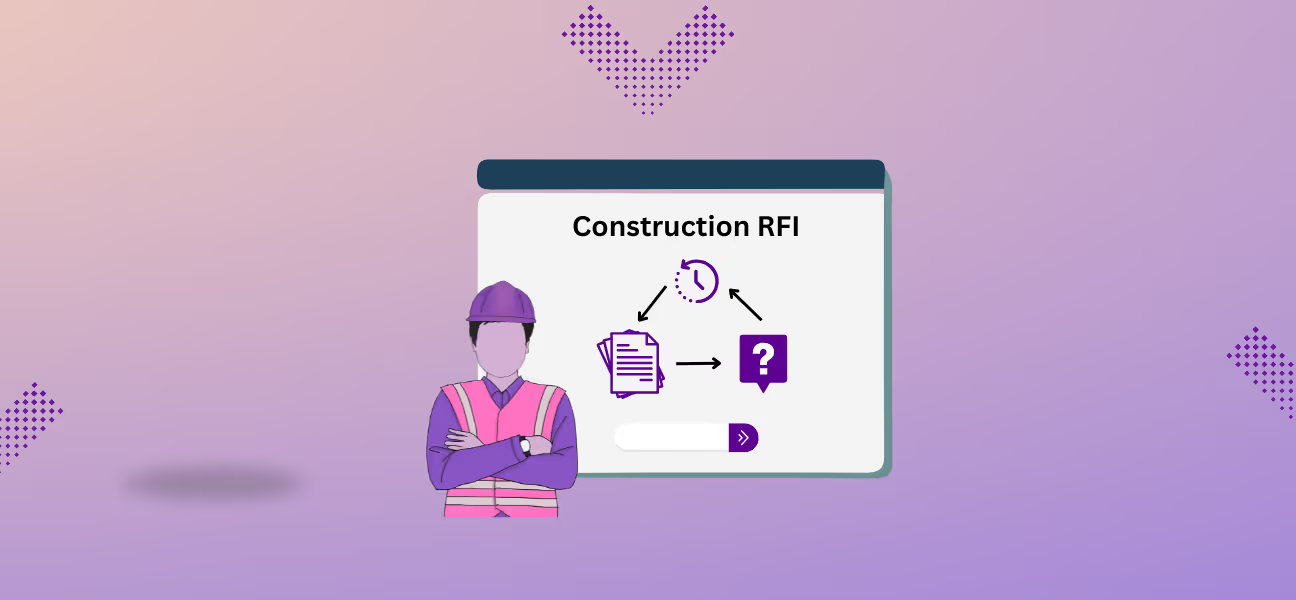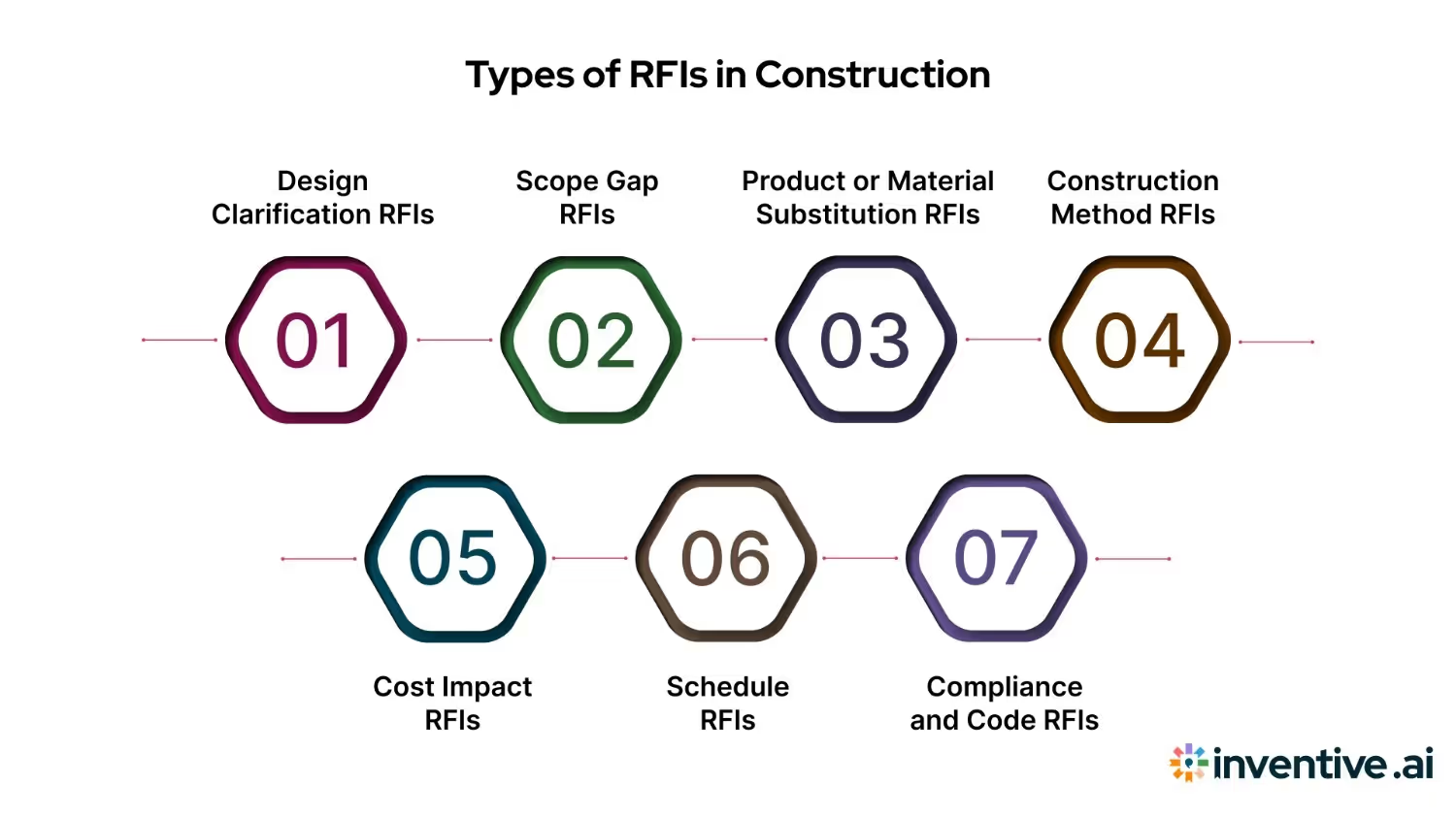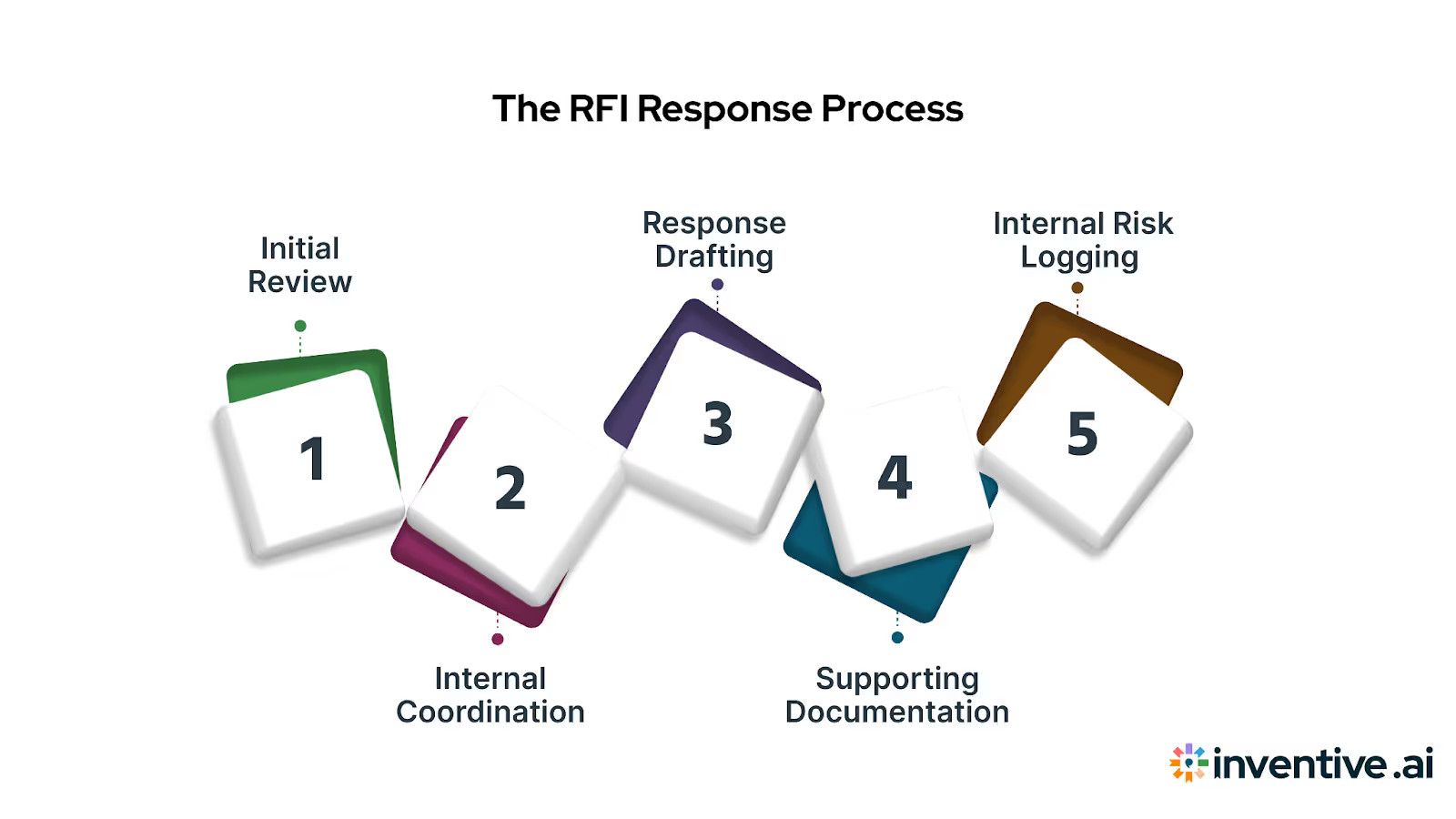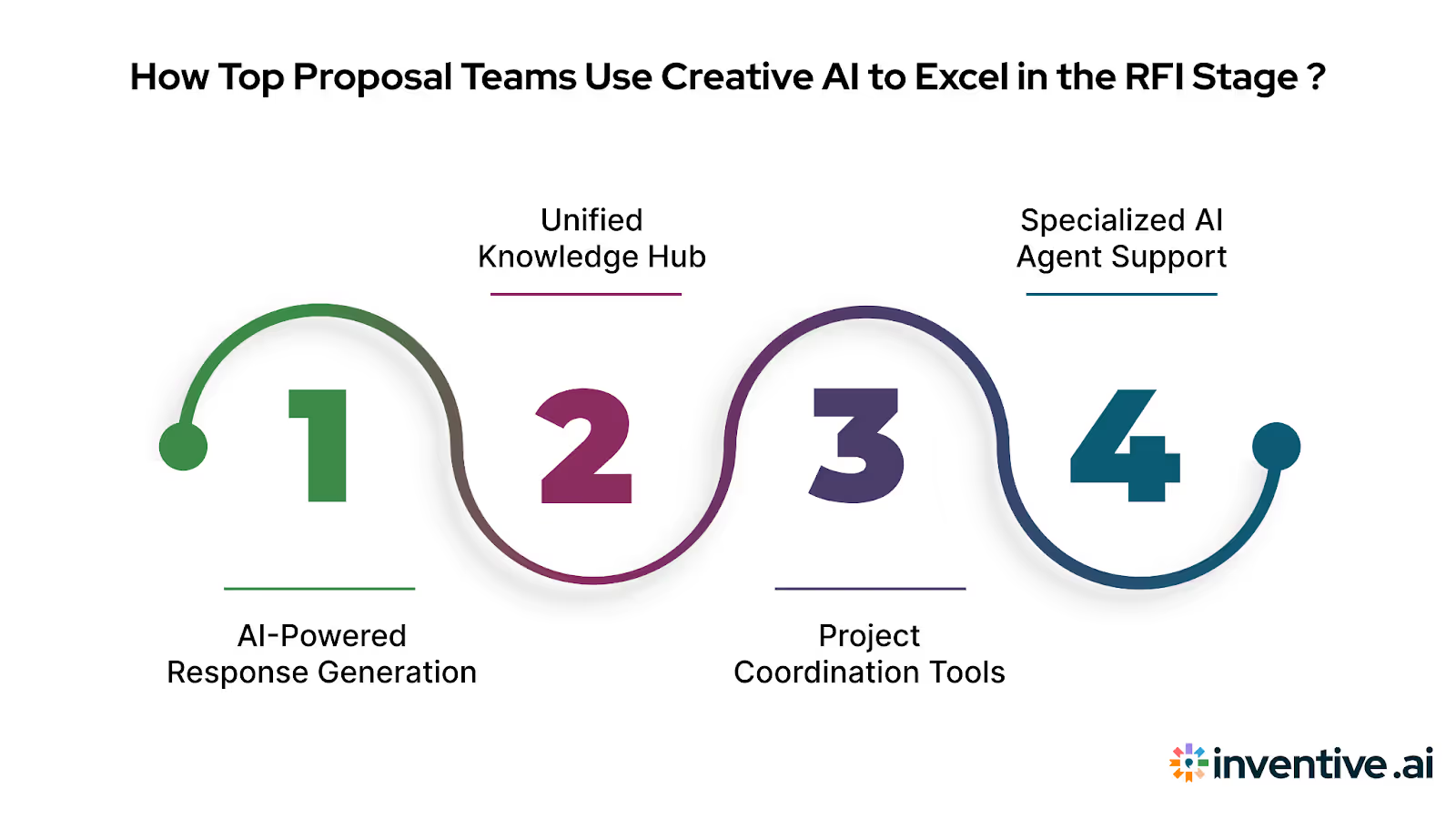Types of RFIs in Construction Explained
Wondering how many different types of RFI are there in construction? Learn key RFI categories, response tips, and how AI tools streamline the process.

RFIs rarely come one at a time or from a single source. On complex construction projects, it’s common to receive simultaneous RFIs from multiple vendors across trades: a civil contractor requesting clarification on drainage design, a subcontractor inquiring about riser alignment, and a structural fabricator proposing a steel substitution. Each request serves a different purpose, but most teams still rely on a one-size-fits-all response template.
That approach undermines both speed and defensibility. When commercial RFIs are treated like technical clarifications or scope-affecting queries are answered without qualifiers, it exposes the contractor or vendor to change order disputes, missed claims, or costly rework. Understanding the function and intent of each RFI type is critical, not just for responding effectively, but for protecting contractual position and delivery timelines.
This guide is built for vendors, subcontractors, and SME teams managing RFI workflows in high-pressure build environments. We’ll break down the different RFI types, explain why treating them uniformly is risky, and walk through practical strategies for drafting tailored, defensible responses.
TL;DR
- RFI in construction is a formal query used to clarify scope, design intent, or contract terms during the construction process.
- RFI common types include design clarifications, scope gaps, coordination issues, material substitutions, and constructability concerns.
- Effective RFI responses should align with the RFI’s intent, clearly flag any scope changes, include relevant documentation, and avoid using generic templates.
- Inventive AI’s RFI Agent extracts context, drafts scoped replies, and cuts down SME review time.
What Is an RFI in Construction?
A Request for Information (RFI) in construction is a formal inquiry submitted during project execution to clarify contract documents, resolve design ambiguities, or address missing technical details. Unlike pre-award documents like RFPs or RFQs, RFIs are triggered mid-project, often when the field team encounters unclear specifications or conflicting instructions that prevent safe or compliant work from proceeding.
An RFI can be issued by the general contractor, architect, engineer of record, or the owner’s representative. But the responsibility to respond, accurately, and quickly, typically falls to subcontractors, product vendors, or discipline-specific consultants. That’s where risk comes into play. Every response becomes part of the permanent project record and may influence how scope, responsibility, or liability is later interpreted.
In most construction management systems, the RFI log acts as a contract artifact. Whether you’re confirming an installation detail, offering a product substitution, or flagging a scope gap, your written reply can affect change orders, claim resolution, or payment approvals.
Why Are Construction RFIs So Important?

Construction RFIs are often dismissed as routine paperwork—but for vendors and subcontractors, they function as legal triggers, schedule drivers, and financial risk flags. A single RFI can significantly influence how the scope is interpreted, the pace of fieldwork, and whether additional costs are approved or absorbed.
RFIs serve three critical functions:
- They prevent execution errors by resolving technical ambiguity before materials are ordered or work is installed.
- They document scope boundaries, especially when responsibility is contested across trades or unclear in contract drawings.
- They trigger schedule and cost adjustments when unexpected site conditions or design changes arise.
Delays in answering RFIs ripple through the job. Missed deadlines can stall inspections, defer procurement approvals, or delay dependent subcontractor work. According to a study, the average direct cost of responding to a single RFI is $1,080, and large projects typically generate over 1,000 RFIs, many of which carry cost or scope consequences if mishandled.
For high-value trades like MEP (Mechanical, Electrical, and Plumbing), structural steel, and curtain wall systems, the stakes are even higher. A vague or overly broad RFI response can lead to misbuilt assemblies, failed inspections, or rework at the vendor’s expense, outcomes that compound quickly across large-scale installations.
RFI vs. RFP, RFQ, and RFT: What Is the Difference?
While they may sound similar, RFIs, RFPs, RFQs, and RFTs serve different purposes across the construction lifecycle, and only one of them occurs after the contract is awarded. Understanding the difference is critical for vendors and subcontractors who move from bidding to execution.
Here’s how each document fits into the construction workflow:
The key distinction is timing. RFIs are issued during the live project, typically when the field team identifies a gap, conflict, or ambiguity in the construction documents. By the time you receive an RFI, your scope is already under contract, meaning your response may affect how that scope is interpreted, costed, or sequenced.
Unlike RFPs or RFQs, which shape whether you win the work, an RFI shapes how you’ll execute it and whether you’ll be held to assumptions you didn’t intend to make.
Even in RFI, there are a few types, each of which needs a specific set of responses from you.
Also Read: Understanding Requests for Information (RFI) in the IT Industry
7 Types of RFIs in Construction

Below are the seven most common RFI types you’ll encounter post-award, each with its own strategy for responding.
1. Design Clarification RFIs
Design clarification RFIs are issued when construction documents lack sufficient detail to proceed confidently. These typically arise from ambiguities in architectural or engineering drawings, like missing section cuts, unspecified fasteners, and unclear alignments.
For example, a contractor may submit a design clarification RFI to request details on a storefront head height not fully dimensioned in the architectural elevation, especially when that detail conflicts with the structural framing above.
These RFIs often surface in early construction when crews are laying out geometry and aligning trades across disciplines.
How to Respond to Design Clarification RFIs
Your responses must do more than repeat the drawing. Your reply should validate the design intent, resolve the inconsistency, and preserve alignment across disciplines. If you’re the engineer of record or delegated design professional, flag downstream conflicts introduced by your clarification.
Don't limit your answer to the asked detail; verify that the surrounding conditions (e.g., tolerances, load paths, or substrate compatibility) remain valid. Never confirm a workaround that lacks anchorage validation or thermal breaks unless you've explicitly reviewed those impacts.
2. Scope Gap RFIs
Scope gap RFIs address ambiguous trade boundaries, typically when contract documents don’t assign a responsibility for a system or item. These often emerge during mobilization or procurement.
For instance, a drywall subcontractor might raise a scope gap RFI asking who provides backing plates for restroom accessories, especially if they’re shown in plumbing elevations but not in the interior partition schedule.
Scope gap RFIs are frequently submitted by subcontractors reviewing coordination drawings or during subcontractor buyout.
How to Respond to Scope Gap RFIs
Responses to scope gap RFIs must be anchored in bid documents, proposals, and contract language. Avoid the trap of passively absorbing scope that was never yours.
If you're a vendor or fabricator, reference original exclusions and clarify assumptions. State clearly who has design and installation responsibility under the contract and whether the item is a cost add.
If ambiguity persists, escalate the issue by requesting a change directive or a formal scope assignment to prevent downstream disputes.
3. Product or Material Substitution RFIs
Product substitution RFIs are generated when a contractor proposes an alternate material, often to mitigate cost, lead time, or availability constraints.
For example, a GC(General Contractor ) may request to swap a specified fire-rated insulation with an in-stock variant that meets the same ASTM (American Society for Testing and Materials )standard but from a different manufacturer.
These RFIs typically arise just before procurement deadlines, especially in volatile material markets.
How to Respond to Product Substitution RFIs
Every substitution RFI should be treated as a mini submittal. Include a matrix comparing technical performance, warranty terms, certifications, and code compliance.
If you're the supplier, confirm that the alternate won’t trigger changes in Underwriters Laboratories (UL) assemblies, shop drawings, or inspection requirements.
Don’t approve based on performance spec match alone; check coordination needs, aesthetic differences, and installer familiarity. A careless “approved” here can nullify warranty obligations or introduce latent defects.
4. Construction Method RFIs
These RFIs arise when a contractor proposes a different installation sequence, means, or method than shown in the documents, often in response to site constraints or sequencing conflicts.
For example, a field crew may suggest pre-welding embeds onto steel columns rather than field epoxying them later, to avoid delays caused by scaffold access.
These types of RFIs are often time-sensitive and tied to ongoing site progress.
How to Respond to Construction Method RFIs
Construction method RFIs require technical scrutiny. Confirm that the proposed sequence doesn’t invalidate testing protocols, affect load transfer, or require revised inspections.
If you're a structural consultant or commissioning agent, verify that method changes don’t interfere with special inspections or third-party verifications. Respond in writing that formal approval is contingent on stamped revisions or inspector buy-in.
5. Cost Impact RFIs
Cost impact RFIs are issued when a potential change or ambiguity may affect the subcontractor’s pricing. These often follow earlier clarification RFIs or Value Engineering (VE) discussions.
For instance, a contractor may ask whether using a 4” curb instead of a 6” curb at a loading dock saves on concrete and forming cost. These RFIs typically arise during change order pricing or VE workshops.
How to Respond to Cost Impact RFIs
Cost-related RFI responses must be structured, traceable, and qualified. Always note whether pricing is a rough order of magnitude (ROM) or final, and flag missing scope information if assumptions are required.
If the impact of labor, access, or schedule is unclear, state that pricing is contingent upon field validation or further scoping. Never use vague terms like “TBD”; instead, offer a qualified estimate and request formal pricing direction. Use a standardized format whenever possible to avoid scope creep disputes later.
6. Schedule RFIs
Schedule RFIs are submitted when there’s a question or conflict regarding sequencing, installation windows, delivery logistics, or inspection dates.
For example, a subcontractor may issue a schedule RFI to confirm whether framing can start before the MEP overhead rough-in is complete. These RFIs often come from superintendents or project engineers navigating the master schedule.
How to Respond to Schedule RFIs
Your reply must account for lead times, field readiness, and labor loading, not just calendar dates. If you’re a trade partner, include crew availability, dependency risks, and any float margins.
Avoid committing to dates without alignment on access or prior trade completion. If the RFI implies a shift in the critical path, flag the impact immediately and request a written schedule re-baseline or owner notification.
Don’t greenlight a date just to “keep the job moving”, you may be absorbing delay liability.
7. Compliance and Code RFIs
Compliance RFIs are issued when the project team needs clarification on building code interpretation, fire rating continuity, ADA (Americans with Disabilities Act) requirements, seismic restraint, or jurisdictional exceptions.
For instance, the contractor may ask whether an access panel can be located within a 1-hour-rated shaft wall. These are high-risk RFIs, often tied to inspections, closeout, or third-party review.
How to Respond to Compliance RFIs
Responses must cite applicable code sections, UL details, or jurisdictional precedent. If you're a vendor, only reply using listed product data or third-party certifications; never guess code equivalency.
Where uncertainty exists, suggest routing the question to the AHJ (Authority Having Jurisdiction) or code consultant. Documenting the code path and attaching relevant documentation reduces exposure during post-construction audits or legal disputes.
Each RFI type carries distinct technical, contractual, and commercial weight, and your response needs to match that weight. Whether you’re addressing a drawing inconsistency or a potential cost impact, a templated or casual reply risks exposing your firm to scope creep, rework, or liability.
Now that we’ve covered the different RFI types and how to approach them, let’s look at how the response process works from assignment to submission, so you can structure replies that are timely, accurate, and defensible.
The RFI Response Process: How It Works

Once an RFI is issued, it’s assigned to the relevant subcontractor, vendor, or trade partner with a defined response deadline. From that point, the clock starts ticking.
Here's how top teams handle it:
1. Initial Review: Begin by reviewing the full RFI thread, initiator notes, and any referenced spec sections or drawing sets to understand the context, not just the question.
2. Internal Coordination: Loop in subject matter experts (SMEs), estimators, or consultants as needed to validate technical feasibility, check material availability, or flag scope creep.
3. Response Drafting: Write a scoped, defensible answer. Focus on clarity, traceability, and risk containment, not just speed. Avoid vague or overly general responses.
4. Supporting Documentation: Always attach marked-up drawings, product data, or code references to substantiate your position. Don’t rely on text explanations alone.
5. Internal Risk Logging: Maintain your own internal record of assumptions, disclaimers, or cost/time implications. GC platforms do not preserve your risk posture—this is your responsibility.
What to Include in a Construction RFI Response
A solid response to construction RFI typically includes:
- Scoped language: Frame answers with context, e.g., “Based on Drawing A101 Rev3, our understanding is…”
- Clear directive: Give a firm yes/no or actionable recommendation.
- Visual markup: Attach marked-up plans or sketches where applicable.
- Product data: Include cut sheets, compliance certificates, or technical specs.
- Cost/time impacts: Flag changes to budget or timeline—even if approximate.
- Assumptions: Document what your answer relies on, e.g., “Assumes install per Detail 7/S2.3.”
What to avoid:
- Vague commitments: Skip soft language like “We’ll try to…”
- Overpromising: Don’t make commitments without internal sign-off.
- Blanks: Leave no gaps in pricing, scheduling, or responsibility.
AI vs. Manual RFI Processing: A Side-by-Side Comparison
RFI responses have long been hindered by manual inefficiencies, including duplicate entries, lost email chains, delayed clarifications, and incomplete documentation. These gaps don’t just slow teams down; they can introduce compliance risk, budget overruns, and rework.
As AI adoption grows across the construction industry, the pressure to modernize RFI workflows is mounting. In fact, the AI construction market is projected to reach $ 11.85 billion by 2029, with a compound annual growth rate (CAGR) of 24.31%.
Here’s how the two approaches compare across key dimensions of the RFI lifecycle:
The contrast is stark. Manual RFI workflows leave room for error and delay at every step. AI tools replace this with real-time visibility, consistency, and decision-ready outputs, so teams spend less time decoding documents and more time building the right solution.
Why Top Proposal Teams Use Inventive AI to Win the RFI Stage

Responding to RFIs at scale is rarely about just writing answers—it's about speed, accuracy, coordination, and reuse. Inventive AI is built specifically to handle these real-world demands, giving proposal teams a central place to generate, manage, and submit high-quality responses faster.
Key Features:
- AI-Powered Response Generation: Get 10× faster first drafts trained on your own documentation. Instead of starting from scratch, teams receive context-aware, scoped responses aligned to project language and tone, reducing SME hours and minimizing rework.
- Unified Knowledge Hub: All reusable content, whether stored in SharePoint, Google Drive, or legacy folders, is centrally indexed and version-controlled. This ensures responses stay consistent, on-brand, and audit-ready, even as teams scale or shift.
- Project Coordination Tools: Task assignment, status tracking, and smart reminders are built in, keeping SMEs aligned and eliminating bottlenecks. Decision-makers can track progress at a glance and reduce turnaround time across concurrent RFIs.
- Specialized AI Agent Support: Beyond drafting, the AI agent identifies information gaps, proposes clearer language, and adjusts tone or technical depth based on the recipient. This improves response quality, reduces back-and-forth, and raises win rates on complex bids.
Ready to transform your RFI process? Request a demo and see Inventive AI in action.
Conclusion
RFIs aren’t mere paperwork; they define the early terms of engagement, shape project scope, influence buyer perception, and carry downstream legal and financial weight. Yet too often, teams rush through them, relying on fragmented notes, outdated templates, or overburdened SMEs.
Vendors who treat RFIs as strategic artifacts rather than routine administrative tasks are better positioned to set terms, manage expectations, and avoid costly rework or disputes later.
What if your team could respond faster, without sacrificing accuracy or control? Inventive AI makes that possible. With AI-powered response generation, centralized knowledge access, and built-in collaboration tools, your team can submit faster, clearer, and more defensible answers. You spend less time chasing context and more time shaping it.
Request a Demo to see how Inventive AI can streamline your RFI process.
What Our Customers Are Saying
Inventive has been a game changer. We have been 3X more productive. We have received consistently high-quality responses, fostering strong trust in the tool. Moreover, the team has been very responsive to our needs.
Rick S. (Director of Sales Operations)
Future of RFP/RFI/security questionnaire responses! Saves our team a ton of time. Lot of great features. User experience is extremely intuitive, and the team is very responsive.
Ben H (Head of Solutions)
FAQs
1. Are RFIs legally binding?
Not inherently, but they can carry legal weight. If an RFI response is used to guide execution and no formal clarification follows, it may be treated as a de facto contract modification. Always respond with care and keep documentation clear.
2. What’s the typical turnaround time for a construction RFI?
Most RFIs are expected to be answered within 1–3 business days. Delays beyond this window can trigger project slowdowns or formal schedule impact notices. A consistent process for triaging and routing RFIs helps avoid unnecessary delays.
3. Can I reject an RFI?
Yes. If the request is outside the current scope, you can respond with “Out of Scope” and escalate for potential change order review. Documenting this properly protects both parties and avoids informal scope creep.
4. Do I need to include pricing in every RFI response?
Not always. Pricing is only required when the RFI suggests a change in scope, design, or materials. In such cases, provide a qualified estimate and clearly state any assumptions or dependencies.
5. How does Inventive AI assist with RFI management?
Inventive AI reduces response time by automatically pulling historical context, generating draft responses tailored to the request, attaching relevant documents from shared drives or past submissions, and minimizing the burden on SMEs. It helps teams move faster without compromising on quality or control.

